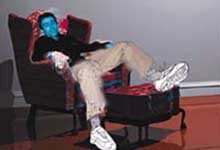



 Back to introduction
Back to introduction | Where are they now? |
|
2022 CHECKOUT STAFF Supermarkets no longer need checkout staff because the ubiquity and cheapness of computer chips mean that bar coding for price and stock flow is obsolete. All products sold in supermarkets now have built-in chips. These send infrared instructions to debit store cards as customers leave. Robots restock the shelves. SC

2024 PIGEONS 2025 BENAZIR BHUTTO |
|
What's your vision of the future? Add to the debate live here.
Alternatively, you can join in the discussions in our online forum, or email your thoughts to |
|
David Biedermayer
DAY OR NIGHT holds no meaning for me. There are no windows where I live because I find the changing light distracting, but I am enslaved by my body's circadian rhythms; I wake for a pee at 9am and I must have a cup of tea shortly after. I am constantly irritated by the demands my body makes on me. It is an outmoded, unreliable and untrustworthy form of transport; it malfunctions often and tires easily. The point of my work is to explore visually what we are and to examine what we could be. Our biggest barrier is our own psyche. Human thought is programmed to recede. We can barely look beyond the beginning of next week, never mind into the next millennium. We are absorbed in our memories and reflections. We cannot conceive of what we could become. My life's work is to push the boundaries of modern conceptual post-humanism. Much of my living space is painted white but the area where I sleep and do my thinking is a pale, speckled flesh tint. I found the paint through a prosthetics supplier on the Lower East Side. It's perfect. It shimmers like a vast membrane. My one concession to comfort is a padded armchair and a round pouffe on cabriole legs on which I like to put my feet of an evening. They are icons, relics from Barnsley and a bygone age, and together they form a metaphor for lost leisure time. I dress in functional clothes; I hate gimmicks and fashion of any kind - it is merely coincidence that my all-in-one suits are exactly in line with the trend for reductionism. For me, life has to be stripped bare of all non-essential frippery in order to assess what is truth. It is probably what makes me so difficult to live with. Well, that and the trail of wires and monitors and prostheses attached to my body day and night. I have experimented with cyber arms but found them clumsy and itchy, so I am beginning to grow another limb from transplanted foetal tissue on my upper right back. The last installation involved paralysing my body while electronic connectors took over its functioning - very uncomfortable but liberating. My new installation, The Pleasure and Terror of Domestic Life, looks at the individual's place in modern society. In Part 1, a couple appear, seemingly absorbed in their inconsequential domestic pursuits, assembling the signifiers of home and family, stabilising society in its fundamental unit. But, in capturing reality, too much is revealed and the pleasure of the ideology is spoilt. We must feed our need to go deeper, and so in Part 2 the audience is invited inside. Through nanorobots, the body itself becomes the installation, opened like a flower to reveal living sculpture. Stretched and penetrated by machines, the skin is no longer an effective boundary. All is ebb and flow, ebb and flow. The space darkens and the body's brainwaves can be seen, electronically enhanced, the only sound the swoosh of blood as it hurtles through the vascular system. We have had accidents. Once, years ago, when the robots were rather more micro than nano, one surfaced - well, I say surfaced: in fact, the subject vomited copiously all over the work space and the robot was expelled into the audience. The audience thought it was marvellous, naturally. One reviewer called it "Biedermayer's triumph", claiming that the expulsion represented "man's historic battle to control his own destiny". Absolute crap, of course, but I liked it. I even thought of incorporating it next time. My critics have claimed that I hate the human body, that my work desecrates humanity and art. But my work is not born of hatred, nor is it emotional. I simply feel that the human body has had its day, that it is obsolete. We have managed to design computers so much more intelligent than we are that they have the capacity to design a species far more useful than Homo sapiens. Food is anathema to me, I am sure that with daily starvation and some alteration to the architecture of my body, I have the ability to evolve on a higher plane as a post-evolutionary vessel, diverse in form and function. However, all the evidence suggests that this is going to be a long haul. I am finding it necessary to do away with the body's very structure. Of course, in human terms, this means death. For me, it is merely the final installation in a life's work. To stage my own death and plan the public escape of my psyche must be the ultimate goal. Interview by Caroline Scott Portrait by Daniel Mackie Go to - Home |
